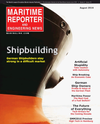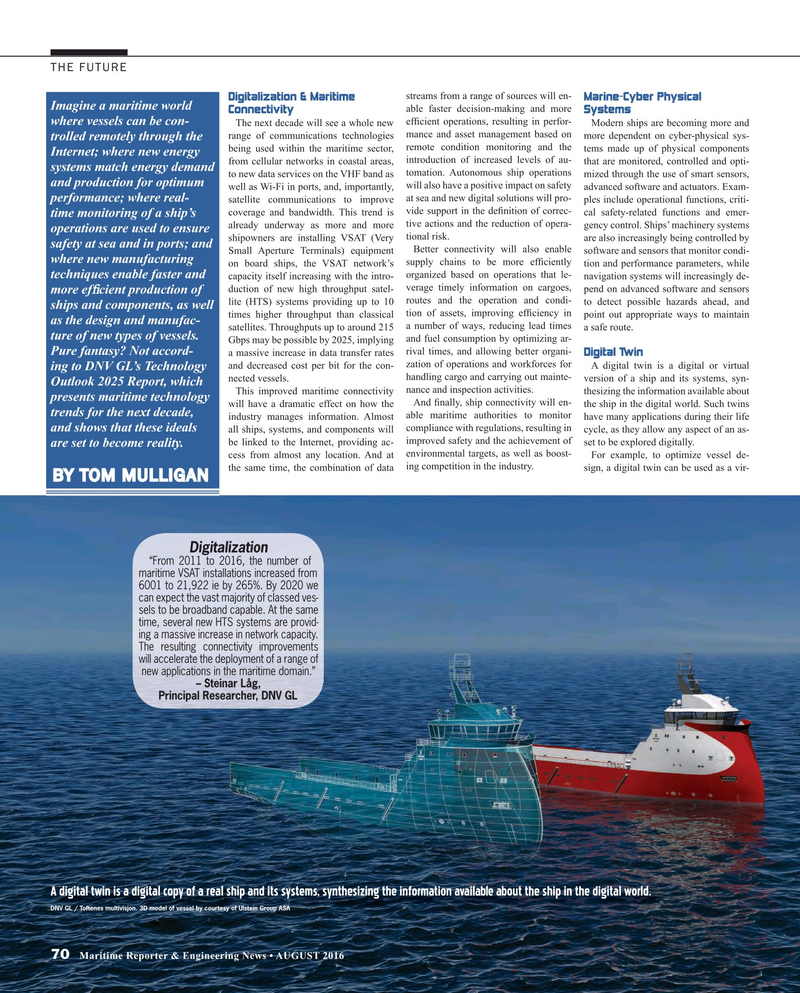
Page 70: of Maritime Reporter Magazine (August 2016)
The Shipyard Edition
Read this page in Pdf, Flash or Html5 edition of August 2016 Maritime Reporter Magazine
THE FUTURE streams from a range of sources will en-
Digitalization & Maritime Marine-Cyber Physical
Imagine a maritime world able faster decision-making and more
Connectivity Systems where vessels can be con-
The next decade will see a whole new ef? cient operations, resulting in perfor-
Modern ships are becoming more and range of communications technologies mance and asset management based on more dependent on cyber-physical sys- trolled remotely through the being used within the maritime sector, remote condition monitoring and the tems made up of physical components
Internet; where new energy from cellular networks in coastal areas, introduction of increased levels of au- that are monitored, controlled and opti- systems match energy demand to new data services on the VHF band as tomation. Autonomous ship operations mized through the use of smart sensors, and production for optimum well as Wi-Fi in ports, and, importantly, will also have a positive impact on safety advanced software and actuators. Exam- performance; where real- satellite communications to improve at sea and new digital solutions will pro- ples include operational functions, criti- coverage and bandwidth. This trend is vide support in the de? nition of correc- cal safety-related functions and emer- time monitoring of a ship’s already underway as more and more tive actions and the reduction of opera- gency control. Ships’ machinery systems operations are used to ensure shipowners are installing VSAT (Very tional risk.
are also increasingly being controlled by safety at sea and in ports; and
Small Aperture Terminals) equipment Better connectivity will also enable software and sensors that monitor condi- where new manufacturing on board ships, the VSAT network’s supply chains to be more ef? ciently tion and performance parameters, while organized based on operations that le- techniques enable faster and capacity itself increasing with the intro- navigation systems will increasingly de- duction of new high throughput satel- verage timely information on cargoes, pend on advanced software and sensors more ef? cient production of lite (HTS) systems providing up to 10 routes and the operation and condi- to detect possible hazards ahead, and ships and components, as well times higher throughput than classical tion of assets, improving ef? ciency in point out appropriate ways to maintain as the design and manufac- satellites. Throughputs up to around 215 a number of ways, reducing lead times a safe route.
ture of new types of vessels.
Gbps may be possible by 2025, implying and fuel consumption by optimizing ar-
Pure fantasy? Not accord- a massive increase in data transfer rates rival times, and allowing better organi-
Digital Twin zation of operations and workforces for and decreased cost per bit for the con- A digital twin is a digital or virtual ing to DNV GL’s Technology handling cargo and carrying out mainte- nected vessels. version of a ship and its systems, syn-
Outlook 2025 Report, which
This improved maritime connectivity nance and inspection activities.
thesizing the information available about presents maritime technology
And ? nally, ship connectivity will en- will have a dramatic effect on how the the ship in the digital world. Such twins trends for the next decade, industry manages information. Almost able maritime authorities to monitor have many applications during their life and shows that these ideals all ships, systems, and components will compliance with regulations, resulting in cycle, as they allow any aspect of an as- be linked to the Internet, providing ac- improved safety and the achievement of set to be explored digitally.
are set to become reality. cess from almost any location. And at environmental targets, as well as boost-
For example, to optimize vessel de- the same time, the combination of data ing competition in the industry.
sign, a digital twin can be used as a vir-
BY TOM MULLIGAN
Digitalization “From 2011 to 2016, the number of maritime VSAT installations increased from 6001 to 21,922 ie by 265%. By 2020 we can expect the vast majority of classed ves- sels to be broadband capable. At the same time, several new HTS systems are provid- ing a massive increase in network capacity.
The resulting connectivity improvements will accelerate the deployment of a range of new applications in the maritime domain.” – Steinar Låg,
Principal Researcher, DNV GL
A digital twin is a digital copy of a real ship and its systems, synthesizing the information available about the ship in the digital world.
DNV GL / Toftenes multivisjon. 3D model of vessel by courtesy of Ulstein Group ASA 70 Maritime Reporter & Engineering News • AUGUST 2016
MR #8 (66-73).indd 70 8/1/2016 3:46:17 PM

 69
69

 71
71
